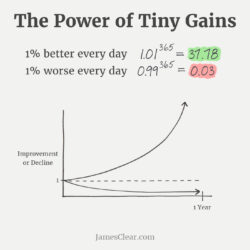By Nordic Walking Watford at

In 2012, Bradley Wiggins became the first British cyclist to win the Tour de France. The next year, his teammate Chris Froome won the race, and he would go on to win again in 2015, 2016, and 2017, giving the British team five Tour de France victories in six years.
Prior to this, professional cyclists in Great Britain had endured nearly one hundred years of underwhelming mediocrity.
Dave Brailsford and the theory of MARGINAL GAINS.
Brailsford had been hired as performance director to put British Cycling on a new trajectory. What made him different from previous coaches was his relentless commitment to a strategy that he referred to as “the aggregation of marginal gains,” – a philosophy of searching for a tiny margin of improvement in EVERYTHING you do.
“The whole principle came from the idea that if you broke down everything you could think of that goes into riding a bike, and then improve it by 1 percent, you will get a significant increase when you put them all together.”
Brailsford and his coaches began by making small adjustments you might expect from a professional cycling team. They redesigned the bike seats to make them more comfortable and rubbed alcohol on the tires for a better grip. They asked riders to wear electrically heated over shorts to maintain ideal muscle temperature while riding and used biofeedback sensors to monitor how each athlete responded to a particular workout. The team tested various fabrics in a wind tunnel and had their outdoor riders switch to indoor racing suits, which proved to be lighter and more aerodynamic.
But they didn’t stop there. Brailsford and his team continued to find 1 percent improvements in overlooked and unexpected areas. They tested different types of massage gels to see which one led to the fastest muscle recovery. They hired a surgeon to teach each rider the best way to wash their hands to reduce the chances of catching a cold. They determined the type of pillow and mattress that led to the best night’s sleep for each rider. They even painted the inside of the team truck white, which helped them spot little bits of dust that would normally slip by unnoticed but could degrade the performance of the finely tuned bikes.
As these and hundreds of other small improvements accumulated, the results came faster than anyone could have imagined.
It is so easy to overestimate the importance of one defining moment and underestimate the value of making small improvements daily. Too often, we convince ourselves that massive success requires massive action. Whether it is losing weight, building a business, writing a book, winning a challenge, or achieving any other goal – we put pressure on ourselves to make some earth-shattering improvement that everyone will talk about.
Meanwhile, improving by 1 percent isn’t particularly notable—sometimes it isn’t even noticeable—but it can be far more meaningful, especially in the long run. The difference a tiny improvement can make over time is astounding.
Here’s how the math works out: if you can get 1 percent better each day for one year, you’ll end up thirty-seven times better by the time you’re done. Conversely, if you get 1 percent worse each day for one year, you’ll decline nearly down to zero. What starts as a small win or a minor setback accumulates into something much more.

In the beginning, there is essentially no difference between making a choice that is 1 percent better or 1 percent worse – it won’t impact you very much today. But as time goes on, these small improvements or declines compound and you suddenly find a very big gap between people who make slightly better decisions on a daily basis and those who don’t. This is why small choices don’t make much of a difference at the time but add up over the long term.
Now you might not find yourself in the Tour de France anytime soon, but the concept of marginal gains can be useful in almost every part of our lives, including Nordic Walking, either to improve performance or just enjoyment.
The Japanese have a similar concept termed KAIZEN, meaning continuous improvement, and it’s certainly the way I try and operate my business.
So, what small changes can we make to improve our Nordic Walking? Let’s start with the obvious:
Obviously, the most important piece of kit for a Nordic Walker, and as a beginner, we encourage you NOT to rush into buying poles but rather to try the different types and really find what works for you. We provide you with a wealth of information to help guide your decision and are always happy to provide advice. So, for instance, a carbon pole is lighter than an aluminum pole so perfect for long distance walking where the weight makes a difference. But if you want to get more of a workout on a short walk then an aluminum pole is the best choice.
Probably the next most important piece of kit and can really make the difference between a miserable walk and a comfortable one. In winter you need a sturdy boot or shoe with a good grip and ideally waterproof – once those feet are wet, you will get cold! And socks are important too – a bad pair of socks can really ruin a good shoe!
Layers are best so you can peel them off as you get warm – and you will get warm Nordic Walking! I prefer to be cold at the start of a walk because I know that within 10 minutes of walking, I will be warm. And I don’t like being too hot when I’m walking. A good waterproof is pretty much essential too and will mean that you at least stay warm if not completely dry.
Discovering a hydration system was a game-changer for me. Previously using a bottle in my rucksack meant I would have to wait until we stopped to have a drink. And by then I was usually already thirsty – which means I’m already dehydrated. So switching to a hydration system (a container of water in your rucksack with a tube for drinking) means I can drink when I need to, in small amounts and more often.
For most of our walks, you shouldn’t need to snack, provided you are well-nourished and hydrated already. However, once you’re walking time gets to around 2 hours, you need to take on board some nutrients. Again something small and often is best so having pockets in the waistband of your rucksack or waist bag means you can access a snack quickly and easily. And try lots of different foods to work out what works best for you.
I found this one online and I struggled to connect it at first…
Why? Well if your current one leaves a strange taste in your water bottle, you are less likely to drink and stay hydrated! This made me think of a walk I led this week in the snow when I asked everyone to stop and hydrate. Cold water on a cold day is the LAST thing you want – so maybe bring a warm drink that you will enjoy.
Hair flapping around your face is an annoying distraction and can potentially be a safety concern, with poles flying around as you try and get some order or even causing a trip or fall.
I’ve worn technical fabric layers for a long time. The benefits are that they wick away moisture from sweating so that you feel more comfortable. But on a charity walk, I did, I was asked to wear a cotton charity t-shirt – and it was a really hot day. Once it was damp it clung to my skin and was close to unbearable, and I vowed never again.
Our feet are so important but can also let us down if we don’t care for them. Trimming toenails regularly, removing hard skin, taping pressure points, applying foot balm / Vaseline/talc – all these things mean we can be comfortable and enjoy our walking.
This means you can get your kit ready, warm up effectively, and get into the right headspace to enjoy your walk. Trying to organise yourself with everyone waiting adds undue pressure and could mean you forget something.
These changes may sound minor and in isolation, they’re not going to be the thing that helps you step up from a Gear 2 to Gear 3, or mean you can increase your distance from 2 miles to 5 miles. But these small improvements when added together can make for more enjoyable walks and, in time, improved performance.
So let me know any marginal gains you’ve implemented that have worked for you.
Every error, every flaw, every failure, however small, is a marginal gain in disguise Matthew Syed
TRACY REEVE
LEAD INSTRUCTOR
NORDIC WALKING WATFORD
Credit : James Clear